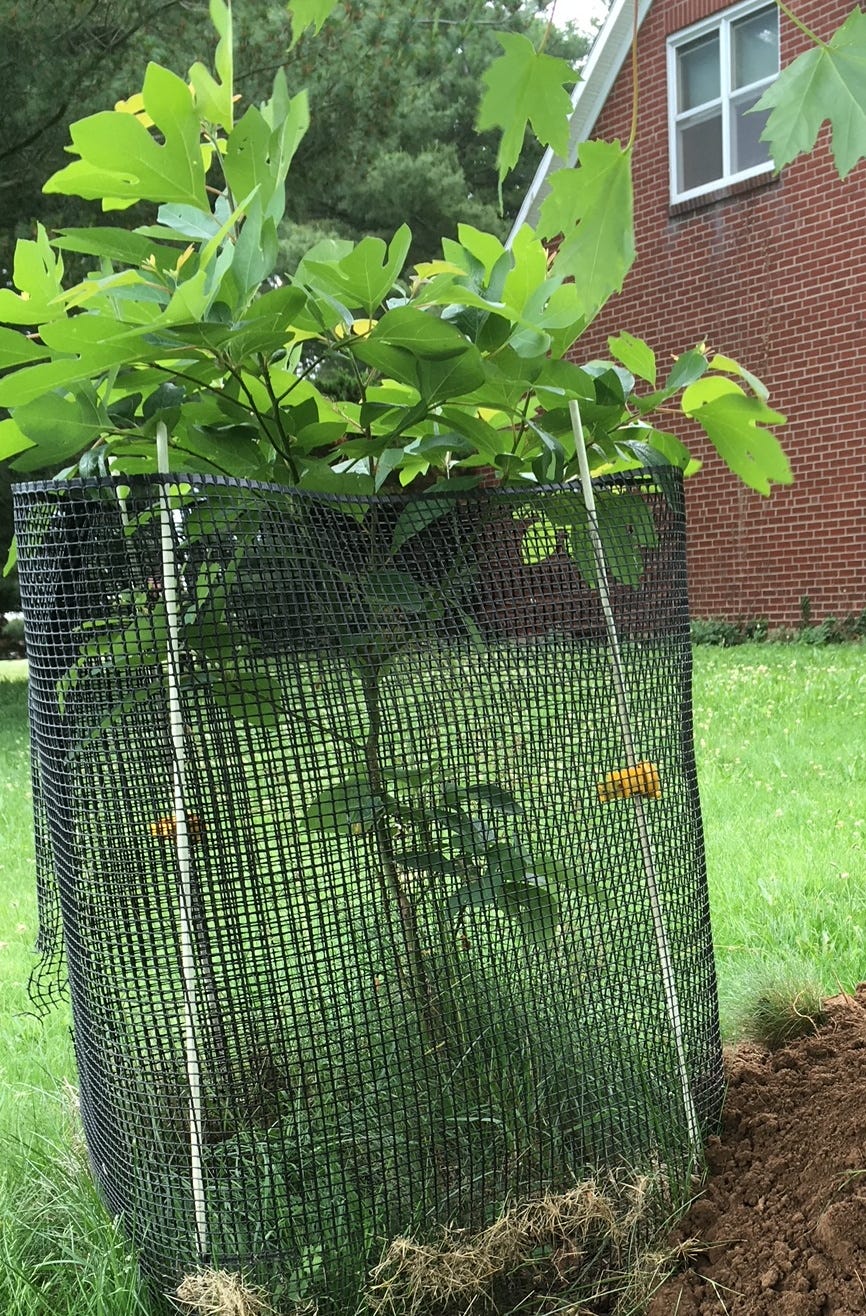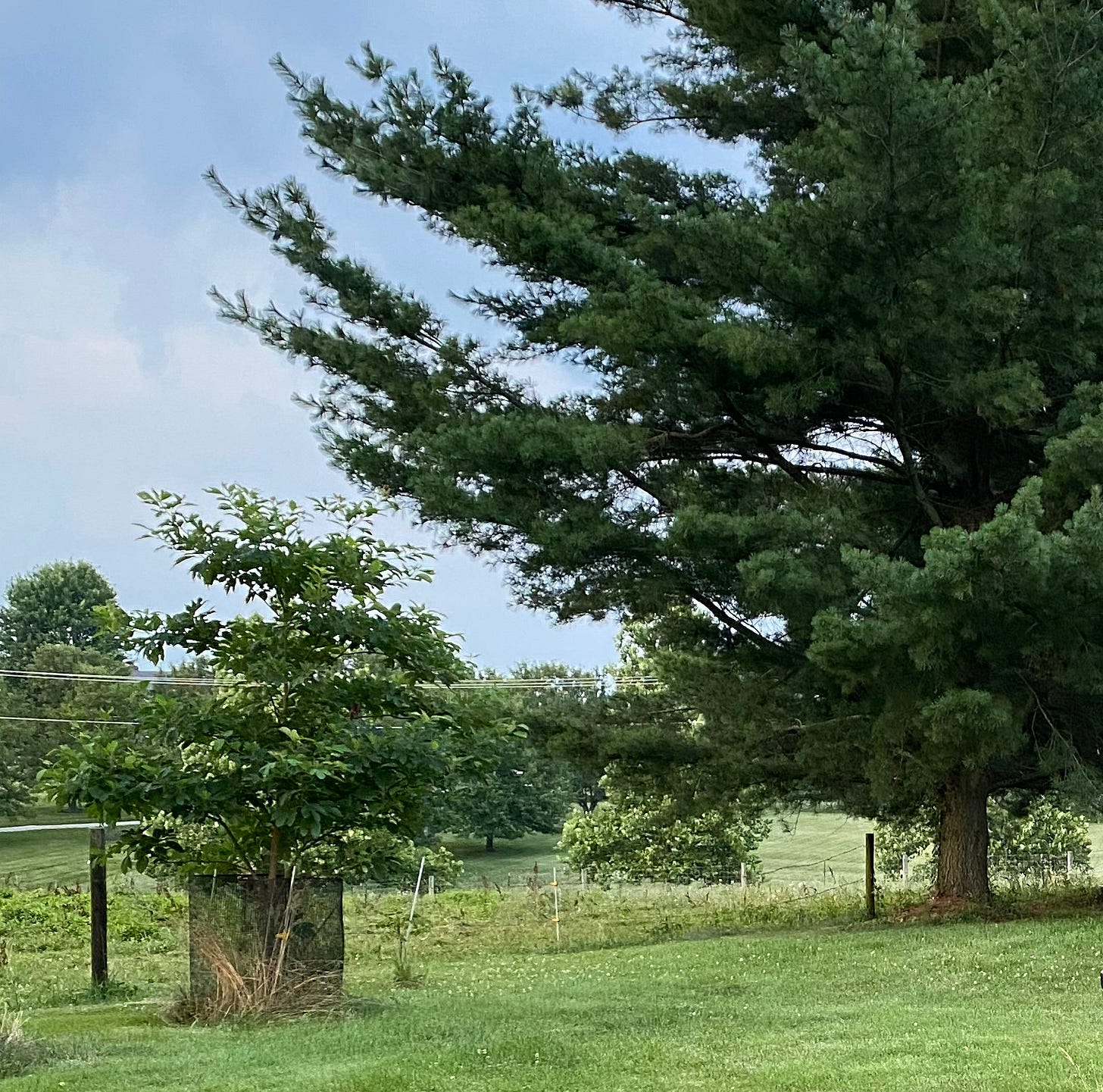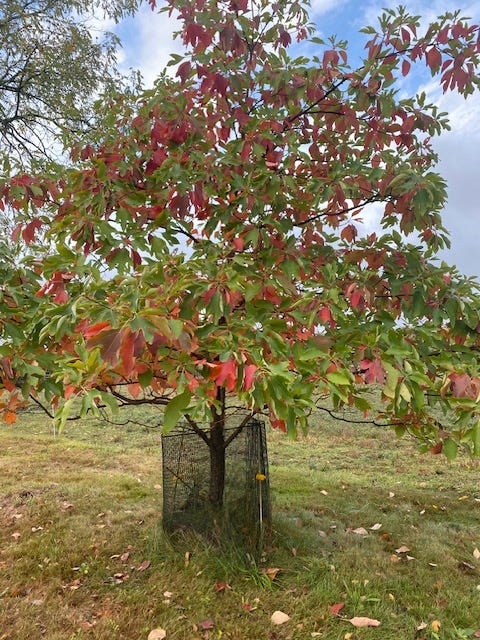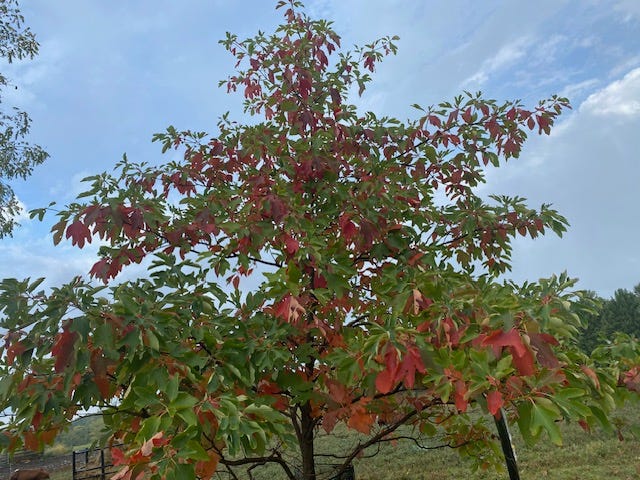In Fall, the irregular foliage of poison ivy assumes brilliant hues of orange - magenta - red, so that’s what jumped into mind when gazing upon the first sassafras tree spotted at weedom. A close inspection revealed that there were 3 different shaped leaves on this mini tree, which stood about 18 inches tall. It had trilobed leaves, mitten shaped leaves, as well as more normally oval shaped leaves. Jackpot! Sassafras! Our coolest new tree, historically famous as the source of root beer flavor, began life as a weed. We hypothesized that a seed had been bombed by a bird next to our greenhouse.
We knew the tree wouldn’t make it in the shade between the oak and the greenhouse, so we moved it to replace a tree that had once lined the driveway to weedom. But a new construction project necessitated that the tree be moved again, and so it now resides in a hallowed spot next to weedom headquarters, where our extended family had, in times past, gathered sociably under a large maple tree. That previous tree lost its life to a small tornado which twisted and dropped it against the house.


After two traumatic transplantings and perhaps 6 plus years of life our sassafras tree is standing over 12 feet tall with the trunk about 6 inches at the base. It has put out some sucker trees in the grass already. We’re not expecting fruit, since that usually takes longer, and this plant is solitary thus far. Sassafras trees are dioecious, having either male or female flowers but both do not occur on the same tree.

Despite the long tradition of sassafras culinary, beverage and medicinal use, the FDA blacklisted its components in 1960. Specifically, any food or cosmetic substance with safrole, (and related products of oxidation, isosafrole and dihydrosafrole) added for flavor or scent, has from that time been deemed as adulterated. This resulted in the reformulation of root beer, and numerous other food, cosmetic and fragrance products, which now have alternative natural or synthetic flavors and scents added in its place. There is no substitute that matches the original. The FDA edict resulted from a finding that a vast overdose of purified safrole in rats was found to be associated with the formation of liver tumors. We have learned that the FDA is recalcitrant, and even after 60 years of finding no association of sassafras usage with tumors in people, and no finding of the toxic responsible metabolite in humans, the ban persists.
As we well know, the U.S. FDA cannot stop the weeds, nor this tree. Therefore they can’t stop clandestine chemists from extracting safrole from the roots and, and using it as a starting material to make the street drugs MDMA, “ecstasy”, with chemical name 3,4- methylenedioxymethamphetamine, and MDA, “sassafras”, with chemical name 3,4-methylenedioxyamphetamine. Proponents of this chemistry think of “ecstasy” as the faster and shorter acting “love drug” and “sassafras” as the longer acting more psychedelic or hallucinatory drug. This unauthorized use of safrole is possibly some of the motivation for the FDA’s continued ban on the use of this natural product for flavoring, scent and cosmetic uses.
Though it’s forbidden to add sassafras roots to any combination product or mixture, they are commonly sold an individual product, and are easy to find online. So people who don’t believe that the sun rises and sets on governmental regulatory bodies can easily obtain the roots even if they can’t grow their own. It is our humble opinion that the real root beer flavor of sassafras is something that’s too good to miss, although you might also want to investigate the multitudinous root concoctions that have been invented as a substitutes.
The Sassafras controversy illustrates many of the fallacies from which regulatory actions flow. Here are just a few.
extrapolating insane dosages of compounds in animals to predict / assume potential harm in humans.
Applying data obtained using concentrated purified substance to whole plant material containing the substance.
equating the efficiency of organic solvent extraction techniques to water extraction techniques.
equating the toxicity of a plant or drug compound to toxicity of an active metabolite, (or vice versa in this case)
assuming that the metabolic processes of an animal model necessarily apply to humans
In short, the safrole itself was not what caused the production of liver tumors in rats. Rather, metabolic products were implicated: 1’-hydroxysafrole (the most potentially toxic) and 3’-hydroxylisosafrole. These products were not found to be produced in humans who ingested safrole.
Safrole is poorly soluble in water (less than 1mg/ml), and aqueous extraction of the root is not an efficient method of extraction. It has been noted that boiling seems to reduce the amount of safrole in water solution over time. Some have suggested that the safrole volatilizes but this seems less likely due to its high boiling point of 450-453 degrees F (232-234 degrees C) and low vapor pressure. Others suggest that heat is hydrolyzing the safrole, which is particularly likely in acidic water solutions. (This seems to apply also to the many other safrole containing herbs and spices used in cooking.) For these reasons people have not been dropping dead as a result of the centuries of traditional production and use of sassafras tea. We are not obtaining anywhere near the prolonged dosing of 750mg/kg per day of safrole associated with liver cancer in rats. The available safrole dose in traditionally prepared tea has been determined to be closer to 3mg/kg per mug of sassafras tea. If you’re wondering about the traditional method for preparing tea from dried sassafras root: 2 grams of chopped, dried sassafras root was boiled in 300ml of water for 15 minutes, then allowed to steep overnight for 12 hours at room temperature, then boiled again for 20 minutes. This is what produced approximately 180 mg total dose of safrole, which would be 3mg/kg if you weigh 60 kg. For this determination, you might thank Kate Cummings, who was wondering how much safrole the Eastern Band Cherokees might be getting from their usage of sassafras tea.
Our tree, Sassafras albidum, a member of the family Lauraceae, can reach heights from 40-60 feet, with some specimens as tall as 100 feet. This species occupies U.S. hardiness zones 4-9 and is seen from Maine to Texas in the U.S. The furrowed grey trunk bark, the reddish bark and lenticels of the small branches, and the green bark of new twigs is unique and can be spotted in winter by those who are familiar with it. Scratching the bark yields a spicy odor, which is more citrusy in the upper branches. The root bark has the deeper root beer like odor. which is imparted to the soil around the roots.
As mentioned above, the three forms of the leaves, trilobed, mitten and oval are distinctive. They’re a matte green color above, and downy white below, and are arranged alternately on the stems. These leaves can be dried and ground to a powder, which in southern cuisine is called filé and added to gumbo as a spice and thickener. Sassafras leaves have much lower safrole content and no one in the FDA appears to be freaking out about filé.
The fruit forms from the pistil of the female flower June or July. It ripens in the fall as bluish black drupe on a red stem, becoming food for myriad species of birds and some mammals, but not for humans. Flowers are about a third of an inch, 0.8 cm across, occurring in short 2 inch racemes. There are 5 to six yellow tepals (looks like a petal, but probably is a sepal). The male flower has 9 stamens, and the female flower has a single pistil and 6 vestigial? stamenoid structures surrounding it.
Some of the other aromatic compounds besides safrole, found within the cortex of sassafras roots are camphor, methoyleugenol, tannins, resin, wax, and minor components pinene, eugenol, apoil, 5-methoxyeugenol, elemincine, estragol, and myristicin. Many of these constituents have allelopathic effects, inhibiting the growth of competing species.
Sassafras looms large in early American history as the second most important export from the New World to Europe. (The top export was tobacco.) The terrific flavor and the medicinal uses fueled demand which was so high that the trees were becoming scarce for a time. The settlers learned traditional uses from the earliest Americans who employed it for syphilis, rheumatism and gout, varicosities, painful menstruation, control of pain after childbirth, as a diuretic, and as a poultice for skin eruptions, and for relief of toothache. The tea made from roots was said to thin and purify the blood when used in the spring. It is Not advisable for pregnant women. Essential oils of roots are concentrated in the cortex, which is a ring of cells just below the epidermis or outer bark. When using small roots, the entire root is simply cleaned and chopped for use. The cortex can be relatively thin ring of tissue just under the outer bark in larger woody roots. Thick outer bark can be scraped away and the inner cortex peeled and dried as the most concentrated source of oils and other medicinal components. Using fresh roots requires considerably less preparation time than the standard extraction mentioned above. Most tea makers drop the roots into cold water, bring it to a boil, simmer for 5-10 minutes, then steep for 10 or more minutes. Expect a pinkish to darker red liquid. If you use 2 grams of dried roots per cup of tea, then use 4-6 grams of fresh root. (Roots lose 60% or more of their water content when dried.) Many tea drinkers sweeten the sassafras tea to balance out the spiciness. We think it’s good with or without added sugar.
Have you tried this tea? What do you mix with it? Are any of you cooking with the filé?? Let us know what you think!
Where We Dig
1. Benedetti MS, Malnoë A, Broillet AL. Absorption, metabolism and excretion of safrole in the rat and man. Toxicology. 1977;7(1):69-83. doi:10.1016/0300-483x(77)90039-7
2. Cummings K. Sassafras Tea: Using a Traditional Method of Preparation to Reduce the Carcinogenic Compound Safrole. Accessed November 7, 2023. https://tigerprints.clemson.edu/cgi/viewcontent.cgi?article=2345&context=all_theses
3. Hung TY, Chou CT, Sun TK, et al. The Mechanism of Safrole-Induced [Ca2+]i Rises and Non-Ca2+-Triggered Cell Death in SCM1 Human Gastric Cancer Cells. Chin J Physiol. 2015;58(5):302-311. doi:10.4077/CJP.2015.BAD315
4. Hutchens AR. Indian Herbalogy of North America. Shambhala; Distributed in the United States by Random House; 1991. https://openlibrary.org/books/OL1567124M/Indian_herbalogy_of_North_America
5. JUSTIN. A Scientist Stole my Root Beer. Nature’s Poisons. Published September 17, 2014. Accessed November 7, 2023. https://naturespoisons.com/2014/09/17/a-scientist-stole-my-root-beer-safrole-sassafras/
6. McMinn S. How to Steep Sassafras Roots. Chickens in the Road Classic. Published July 30, 2012. Accessed September 26, 2023. https://chickensintheroad.com/classic/cooking/how-to-steep-sassafras-roots/
7. Miller JA, Miller EC. The metabolic activation and nucleic acid adducts of naturally-occurring carcinogens: recent results with ethyl carbamate and the spice flavors safrole and estragole. Br J Cancer. 1983;48(1):1-15. doi:10.1038/bjc.1983.151
8. PubChem. Safrole. Accessed November 7, 2023. https://pubchem.ncbi.nlm.nih.gov/compound/5144
9. Song X, Yin Z, Ye K, et al. Anti-hepatoma effect of safrole from Cinnamomum longepaniculatum leaf essential oil in vitro. Int J Clin Exp Pathol. 2014;7(5):2265-2272.
10. Thayer S. The Forager’s Harvest - A Guide to Identifying, Harvesting, and Preparing Edible Wild Plants. Forager’s Harvest Press; 2006. https://openlibrary.org/books/OL8588402M/The_Forager's_Harvest
11. 10 Surprising Benefits of Sassafras | Organic Facts. Accessed November 7, 2023. https://www.organicfacts.net/health-benefits/other/sassafras.html
12. 21 CFR 189.180 -- Safrole. Accessed November 7, 2023. https://www.ecfr.gov/current/title-21/part-189/section-189.180
13. Root Beer. Accessed November 7, 2023. https://www.diffordsguide.com/beer-wine-spirits/category/270/root-beer
14. Sassafras albidum (Cinnamon Wood, Common Sassafras, Mitten Tree, Sassafras, White Sassafras) | North Carolina Extension Gardener Plant Toolbox. Accessed November 7, 2023. https://plants.ces.ncsu.edu/plants/sassafras-albidum/
15. Sassafras Tea Safety | Food Safety | Andrew Weil, M.D. Accessed November 7, 2023. https://www.drweil.com/diet-nutrition/food-safety/sassafras-tea-safety/
16. Sassafras, An Illegal Substance That Grows Wild In Our Back Yards - Eat The Planet. Accessed November 7, 2023. https://eattheplanet.org/sassafras-an-illegal-substance-that-grows-wild-in-our-back-yards/
17. What Is Sassafras and Is it Safe? | HowStuffWorks. Accessed November 7, 2023. https://recipes.howstuffworks.com/food-science/sassafras.htm






How amazing! A bird must have planted your tree! I've learned a lot tonight about the Sassafras! I wish I could smell it. Thank you for the post! 🤗
Thanks for this! Australia only has sassafras lookalikes of the Cinnamon family and related genera (Atherosperma & Doryphora). The fragrant bark of our sassafras lookalikes was of interest to the early botanists here, also containing appreciable quantities of safrole (70%), but also camphor and some unique (toxic!) alkaloids like atherospermine, berbamine and doryphorine.